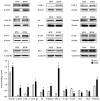Extracorporeal Shock Wave Therapy Alters the Expression of Fibrosis-Related Molecules in Fibroblast Derived from Human Hypertrophic Scar
- PMID: 29301325
- PMCID: PMC5796073
- DOI: 10.3390/ijms19010124
Extracorporeal Shock Wave Therapy Alters the Expression of Fibrosis-Related Molecules in Fibroblast Derived from Human Hypertrophic Scar
Abstract
Extracorporeal shock wave therapy (ESWT) considerably improves the appearance and symptoms of post-burn hypertrophic scars (HTS). However, the mechanism underlying the observed beneficial effects is not well understood. The objective of this study was to elucidate the mechanism underlying changes in cellular and molecular biology that is induced by ESWT of fibroblasts derived from scar tissue (HTSFs). We cultured primary dermal fibroblasts derived from human HTS and exposed these cells to 1000 impulses of 0.03, 0.1, and 0.3 mJ/mm². At 24 h and 72 h after treatment, real-time PCR and western blotting were used to detect mRNA and protein expression, respectively, and cell viability and mobility were assessed. While HTSF viability was not affected, migration was decreased by ESWT. Transforming growth factor beta 1 (TGF-β1) expression was reduced and alpha smooth muscle actin (α-SMA), collagen-I, fibronectin, and twist-1 were reduced significantly after ESWT. Expression of E-cadherin was increased, while that of N-cadherin was reduced. Expression of inhibitor of DNA binding 1 and 2 was increased. In conclusion, suppressed epithelial-mesenchymal transition might be responsible for the anti-scarring effect of ESWT, and has potential as a therapeutic target in the management of post-burn scars.
Keywords: burn hypertrophic scar; epithelial-mesenchymal transition; extracorporeal shock wave therapy; hypertrophic scar-derived fibroblast; inhibitor of DNA binding protein.
Conflict of interest statement
The authors declare no conflict of interest.
Figures







References
-
- Tredget E., Shankowsky H., Pannu R., Nedelec B., Iwashina T., Ghahary A., Taerum T., Scott P. Transforming growth factor-β in thermally injured patients with hypertrophic scars: Effects of interferon α2b. Plast. Reconstr. Surg. 1998;102:1317–1328. doi: 10.1097/00006534-199810000-00001. - DOI - PubMed
MeSH terms
Substances
LinkOut - more resources
Full Text Sources
Other Literature Sources
Medical
Research Materials
Miscellaneous

